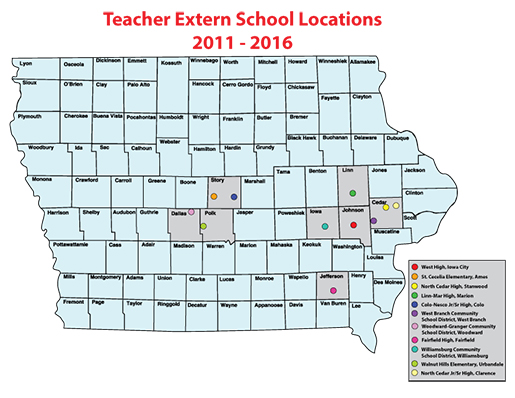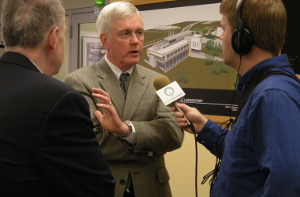Three externs carry on tradition
 Three Iowa teachers who specialize in science and its application will spend part of this summer as externs at the Hygienic Laboratory. Externs are secondary school teachers who specialize in science, technology, engineering or math (STEM).
Three Iowa teachers who specialize in science and its application will spend part of this summer as externs at the Hygienic Laboratory. Externs are secondary school teachers who specialize in science, technology, engineering or math (STEM).
Teachers are chosen by the Iowa STEM Teacher Externships, a project of the Governor’s STEM Advisory Council. They spend six weeks learning about STEM in the workplace, and then share their experiences with students in the classroom.
“The Iowa STEM Teacher Externships program assigns teachers to a host company or agency. The Hygienic Lab has hosted at least one and sometimes up to three teacher externs each summer since 2011,” said Beth Hochstedler, director of the Office of Education, Training and Professional Development. This program provides teachers with real-world laboratory science knowledge and a deeper understanding of career opportunities that they can take back to share with their students.”
Since 2011, the Hygienic Laboratory has hosted 11 teachers from 11 school districts across Iowa.
Science and Administration
 Heather Anderson poses at the Ankeny laboratory where she is working this summer as an extern.
Heather Anderson poses at the Ankeny laboratory where she is working this summer as an extern.Measuring heavy metals in milk for the Iowa Department of Agriculture and Land Stewardship is part of Heather Anderson’s externship at the Hygienic Laboratory this summer. The Minerals and Metal section is one of seven areas that make up the rotational externship model throughout the Ankeny laboratory.
During the school year, Anderson’s work life spans the spectrum from elementary school teacher to a school board member. While teaching at Cowles Montessori School in Windsor Heights, she created an after-school program with a Lego League, two science clubs, a coding club and an environmental club.
Now as a second grade teacher at Walnut Hills Elementary in Urbana in the Waukee Community School District, Anderson champions applied science in her classroom and around the boardroom as a member of the Des Moines Public School Board. Since 2010, Anderson has written and received more than 20 STEM-related grants. In 2015, she received the National Education Association’s Foundation Award for Teaching Excellence.
A Window to Air Quality
The Ambient Air Quality staff will have a live status report of its 21 remote locations thanks to the externship of Matt Cain from West Branch High School.
Cain is developing new graphs of air quality data that will display in real time on a large monitor in the Air Quality section. From this data, staff in Coralville will be able to determine if sites across Iowa need immediate adjustments.
 Externs Matt Cain and Heather Davidson (far right) pose with Allison Streeter, environmental analyst, at the Ambient Air Quality training trailer in Davenport.
Externs Matt Cain and Heather Davidson (far right) pose with Allison Streeter, environmental analyst, at the Ambient Air Quality training trailer in Davenport.In 2013, Cain joined West Branch High School in the new position of STEM teacher and FIRST Robotics Competition instructor. He created a robotics program and implemented curriculum from Project Lead the Way, a national program that provides hands-on educational course materials in computer science, engineering and biomedical science. Cain teaches Project Lead the Way courses in flight and space, engineering design, applied physics and computer science
Telling the Story
An English teacher turned STEM instructor is using both of these fields to tell the story of air quality in Iowa. Heather Davidson, a teacher in North Cedar Jr/Sr High School in Clarence, is creating educational materials about Ambient Air Quality for visitors to the Hygienic Laboratory and educators around the state.
In her role as an educator, Davidson is building a program that gives the small town of Clarence (pop. 965) access to specialized training in technical skills.
North Cedar recently implemented new STEM curriculum. After teaching English to high schoolers for two years, Davidson was recruited to be the school’s first STEM teacher. She is now building the new program for 7th through 12th-grade students.
Since the program began during the 2015 – 2016 school year, Davidson added classes – which she teaches – in computer animation, virtual reality, coding, video game design, STEM and cyber investigation.



